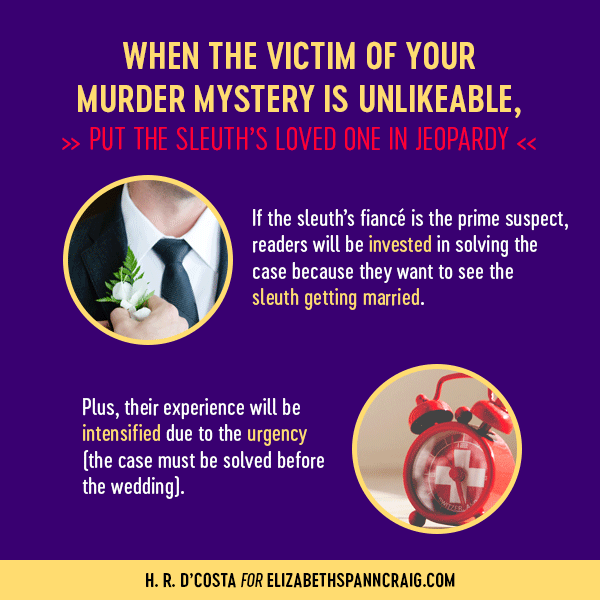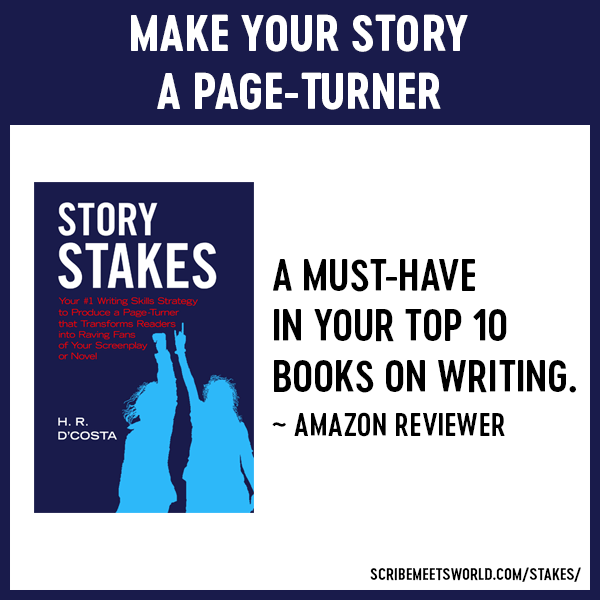
by H.R. D’Costa, @scribesworld
Here’s the scenario:
You’re writing a cozy mystery. And your victim is unlikeable.
Your suspect list is, as they say, healthy.
You’re having a blast coming up with motives for each suspect.
In theory, as your readers engage in their quest to identify whodunit, they should also have a blast weeding through the suspects.
There’s only one problem.
At their core, mysteries are driven by stakes of justice.
If the sleuth identifies and apprehends the murderer, then a wrong will—to a certain extent—be made right. Justice will be served.
Can you see how this creates a conundrum?
When your victim is unlikeable, readers might not really care whether justice is achieved on his behalf or not. If they don’t care, then there’s no reason for them to keep on turning the pages of your cozy mystery.
Definitely not a good position to be in.
Wait…
What About Curiosity?
Isn’t that sufficient to compel readers to continue reading your book?
Curiosity certainly is important. But around the middle of a story, its effect tends to be outweighed by other factors—including a reader’s less-than-keen attitude toward an unlikeable victim.
That said, you may be able to overcome this hurdle if your readers are, like many cozy-mystery fans, strongly attached to your sleuth and your series.
Still, it’s not the ideal.
The ideal circumstance is to secure both curiosity about the plot and emotional involvement in it.
Essentially, your dilemma boils down to this:
How do you get readers to care about solving the murder of someone they don’t really care for?
One option is to bring in a second victim who is likeable. Again, the midpoint of a novel is a good place for this. Why? Two reasons, mainly.
One, another murder shakes things up, preventing the middle from becoming monotonous. (As a side note, you can find more ideas for how to shake things up at the middle of your mystery in a video in Lesson 2.1 of my online course on story structure. Click on that link to access the lesson for free.)
Two, because this second murder involves a likeable victim, it gets readers more emotionally involved in the plot, right when the effect of curiosity tends to decline.
While killing off a likeable character is a solid solution, there are others that can be used (in lieu of, or in tandem with, it) as well. That’s what we’re going to explore in this four-part series about how to handle the stakes in a cozy mystery. (By the way, although the illustrative examples are cozy-centric, many of the tips in this series can be applied to mysteries with a harder edge.)
To give you an overview:
- In Part 1, we’ll cover methods to bolster the stakes that emphasize the sleuth. (You’re reading Part 1 right now.)
- In Part 2 (forthcoming), we’ll cover methods to bolster the stakes that emphasize other storytelling elements that readers care about.
- In Part 3 (forthcoming), we’ll discuss considerations to take into account when applying these story stake tips to cozy mysteries in a series.
- In Part 4 (forthcoming), you’ll see these considerations in action when I share a sample lineup of stakes for a hypothetical cozy-mystery series.
Ready to dive into Part 1? Let’s go!
Put Your Sleuth (Or Someone Close to the Sleuth) in Jeopardy
All right. The victim in your cozy mystery is unlikeable.
Readers might not care two figs for him. By extension, they might not care two figs about the plot, which is all about apprehending his murderer.
However, your readers do care two figs for your sleuth protagonist.
Thus, if you tie the stakes to an outcome that personally affects the sleuth—there’s no way readers will abandon your book. Their attachment to your sleuth, coupled with the stakes, precludes that.
The obvious option (and one which many mystery writers gravitate toward) is to make the sleuth the prime suspect. If she doesn’t solve the case, the murder will be pinned on her, and she’ll go to jail.
With such high stakes as these, is there any way readers will put down your book?
Doubtful, fellow scribe, doubtful.
Of course, when you’re writing a series of cozy mysteries, you can’t use this solution every time. That would strain credibility.
Happily, you can achieve the same effect via different means. The sleuth could be the killer’s next target. If she doesn’t solve the case in time, she might end up dead.
Granted, some astute readers would conclude that if the sleuth went to jail or died, the series would end. So both outcomes are rather implausible.
Nevertheless, many readers are willing to suspend their disbelief on this account and enjoy the emotional roller-coaster ride created by your sleuth’s dire predicament. After all, even if they’re sure she’ll end up alive and well, they still don’t know how she’ll manage to extricate herself.
Keep in mind, because readers care about characters whom the sleuth cares about, you don’t have to limit yourself to jeopardizing the sleuth. To get readers emotionally invested in the plot, it’s equally effective to put a sleuth’s loved one in jeopardy.
For example, let’s say that your sleuth is finally marrying her love interest…only he’s become the prime suspect in a recent murder. Clearly—even though the victim is unlikeable—the plot of this book is going to entangle reader emotions.
Readers will want to see the sleuth solve the case so the wedding can go on, as scheduled!
The best part is that this situation also creates an automatic ticking clock. The sleuth has to solve the case before her fiancé is arrested. Otherwise, there’ll be no wedding.
With this built-in deadline, the urgency is increased, which, in turn, intensifies the reader experience—and makes your book even more addictive.
If you’re writing and/or publishing your own cozy-mystery series, you can play around with these options, using different ones for each book. In the pro column, you’ll achieve variety, and at the same time, avoid straining credibility.
However, depending on when you use each option, you might inadvertently create an escalation problem, where later books in your series feel lackluster compared to earlier series installments. We’ll discuss this issue in more detail in Part 3 and Part 4 of this blog series.
For now, let’s move on to another solution to make readers care about the plot of your cozy mystery even though they don’t care about the unlikeable victim…
Show the Impact the Unsolved Case Has on Your Sleuth’s Everyday Activities
You don’t always have to put your protagonist in extreme jeopardy in order to get readers to invest in the plot. As an alternative, you can explore stakes of access.
In this specific application, the sleuth protagonist will lose access to a place she cherishes if she fails to solve the case. Readers’ desire to see her maintain that access keeps them emotionally involved in the story.
Let me show you what I mean. Say your protagonist is a mystery writer (how meta *wink*). Whenever she has writer’s block, she goes to a local café whose spicy chai tea and calming sitar music unleash her creative muse.
Unfortunately, the town’s snobbiest resident fell dead at the café—and all signs point to murder. Now, the café is avoided like the plague, and its owner says he’ll have to shut it down if things continue the way they are.
Thus, the sleuth has to solve the case. Otherwise, she’ll lose access to her safe haven. Otherwise, she’ll be looking at permanent writer’s block.
Did I mention the sleuth has a publishing deadline to hit?
If she doesn’t make it, she’ll have to return her advance (which she already spent on home repairs). Again, like the wedding example above, this situation creates an automatic ticking clock that’ll intensify the reader experience and turn your book into a real page-turner.
* * *
The tips in this post emphasized readers’ relationship with your sleuth protagonist. However, in the next part of this blog series, we’ll take another tack. We’ll explore options that don’t depend as much on that relationship.
In the meantime, if you’d like to dig deeper on your own, download this cheat sheet with 11 types of story stakes. It might (a) give you additional ideas for how to tie the stakes to an outcome that personally affects the sleuth as well as (b) help you generate a variety of motives to match your healthy list of suspects.
You can also check out my writing guide Story Stakes: Your #1 Writing Skills Strategy to Produce a Page-Turner That Transforms Readers into Raving Fans of Your Screenplay or Novel . See below for details on how you could win a paperback copy!
Win a Paperback Copy of Story Stakes
For every post in this blog series, you have a chance to win a paperback copy of Story Stakes ($15.95).
Described as “a must-have in your top 10 books on writing” by one Amazon reviewer, it’ll show you how to use story stakes to elicit the maximum degree of emotion from readers as well as how to raise the stakes (even when they’re already high!).
For a chance to win today, answer this question in the comments: What characteristic made you fall in love with one of your favorite sleuths?
Elizabeth will randomly select four lucky winners by Monday, August 19.
Note: This giveaway is only open to residents of North America, South America, and Europe.
Good luck and happy writing!
About H. R. D’Costa

A graduate of Brown University, H. R. D’Costa (a.k.a. HRD) is an author and writing coach who specializes in story structure and story stakes.
Known for her “deep dive” instruction style, she is the author of 8 writing guides including Sizzling Story Outlines , Story Stakes, and the 4-volume Story Structure Essentials series .
For practical, actionable writing tips designed to help you keep readers glued to your pages, visit her website scribemeetsworld.com, which is also home to the Ultimate Story Structure Worksheet (downloaded over 37,000 times by writers from around the world).
Handling Unlikeable Victims in a Cozy Mystery by @scribesworld Click To TweetIMAGE CREDITS: Coffee & book by Amariei Mihai; Wide-eyed cat by Simone Dalmeri; Roller coaster by Mark Asthoff; Misty lake by Dominik Dombrowski; Female sleuth by Sasha Nadelyaeva; Fashionable groom by Mélanie Villeneuve; Red clock by Katarzyna Kos; Fancy café by Seemi Samuel







Giving the sleuth something to lose is a good way to get readers emotionally involved.
Nailed it in one, Alex!
These are all good things to think about when setting up a mystery. If readers aren’t invested in the story, they won’t truly engage in it.
You’re right, Margot. Reader investment is so important — as important as the intellectual puzzle of the mystery.
I see stories where it’s the sleuth’s best friend or a sibling in trouble or a suspect and that works very well.
Diane, I love the idea of using the sleuth’s sibling as the stakes. Great suggestion!
If you’re writing a lengthy cozy series, you might give your sleuth a big family, just for this purpose :)
What characteristic made you fall in love with one of your favorite sleuths?
1 Her impulse to volunteer to work at an agency, because she wanted her life to mean something, not just to live out her older years doing what is expected. She wanted the unexpected!
2 Eagerness to bring justice to bad situations, people, etc.
3 Her courage to never give up even in dangerous conditions or harm.
4 Her ability to think outside the box!
Wow, Karen, your favorite sleuth sounds very compelling. Thanks for sharing.
I, too, like when characters can think outside of the box — and admire the authors who are able to come up with such unconventional solutions!
Such a great topic, HRD! Thanks for working through it this week and next!
I really like making the unsolved case impactful for the sleuth. Great way to heighten the stakes!
As for my favorite sleuth’s characteristics, I seem to fall for flawed sleuths. Oddly, I think I was attracted to Poirot’s vanity. :)
Thanks again!
Thanks for hosting me, Elizabeth!
I adored Poirot’s vanity as well. Somehow, it was endearing — at least the way Christie did it.
Excellent post! I love cozy mysteries. I started with Encyclopedia Brown, then Nancy & the Boys, then Agatha Christie!
I love sleuths who don’t give up even when they are afraid :)
Jemi, you named some of my favorites — although, I must confess, I only read the Hardy Boys when they were in a crossover novel with Nancy Drew. Those were fun!
What keeps me coming back to Dave Robecheaux, James Lee Burke’s New Iberia PI/police detective, is his unwavering commitment to defend the defenseless while he wrestles with a mob of demons you know he’ll never exorcise.
Sounds like an intriguing combination, Bill.
I like the way you described it, too: “while he wrestles with a mob of demons you know he’ll never exorcise.”
Cool post! I’m a big fan of the “fish out of water” twist, where the sleuths finds herself without the support she’s been accustomed to in order to solve the case (especially beneficial later in a series).
That’s a good one, K. B.
You’re right — it’s especially effective to execute in later books in a series. Excellent point.
Great tips that I’ll have to remember. My favorite cozy is Agatha Raisin, because she’s middle-aged and grumpy. And sooo funny!
From your description, Gwen, it seems like Agatha is a real hoot!
I’ve heard there’s a TV show based on the books, which looks interesting too.
Janet Evanovich’s Stephanie Plum, is my all time favorite sleuth. I think it’s Stephanie’s ability to see the humor in her own shortcomings that makes her human to me. No matter what the situation, she puts on her big girl panties and handles her business. How can you not love someone like that!
Thanks for coming by, Marcia!
Finding the humor in one’s shortcomings is a great trait to have — both in fiction and in real life. No wonder Stephanie Plum has been popular for so many years!
Excellent post! Cozies are great insofar as the stakes can be “low” (compared to thrillers). We don’t have to threaten lives and loved ones every time. Much better are the personal stakes – pride, guilt – or the loss of a beloved coffeehouse as per your example. Or a friend in trouble. That type of challenge allows to keep the attraction of a series up, which would otherwise fade fast.
Great observations, Lina. Thanks for sharing.
I especially like what you said about keeping the attraction of a series going. As it happens, that’s a topic that’ll be explored in Parts 3 and 4 of this blog-post series!
Great tips, HRD! Looking forward to the next installments in this series.
Thanks for stopping by, Ellen! Or should I say “sailing by”?
Or maybe I should avoid the puns altogether :)
Making the sleuth smart but flawed. Veronica Mars and Sherlock Holmes comes to mind.
“Smart but flawed.” Great combo, Melody.
Sounds like the perfect base recipe for mystery writers to start with, when creating their sleuth character.
The characteristic made me fall in love with Hercule Poirot was his ability to observe and put details together that others overlooked.
Ah, we have another Hercule Poirot fan in the house.
Welcome, Hazel!
Your comment made me remember something else about Poirot: he could see when others were suffering in silence, and would exhibit compassion toward them, which I always liked.
I love sleuths that seem realistic, just perhaps a bit more clever and less concerned with staying out of trouble/ danger than the average person.
That’s a good point, Jen.
Making the sleuth like readers (only slightly more clever and courageous) is a good approach to keep readers invested in the story because it keeps things relatable!
My favorite sleuth is JD Robb’s Det. Peabody. I love her combination of insecurity, Mother Earth nurturing, and desire to kick ass, as well as a finely tuned skill for sucking up.
I have a confession, Carol. I’ve only read Nora Roberts when she’s written as Nora Roberts. I haven’t read any of her JD Robb books.
But after a description like that, I’m definitely intrigued! I can see why Det. Peabody is one of your favorite sleuths.